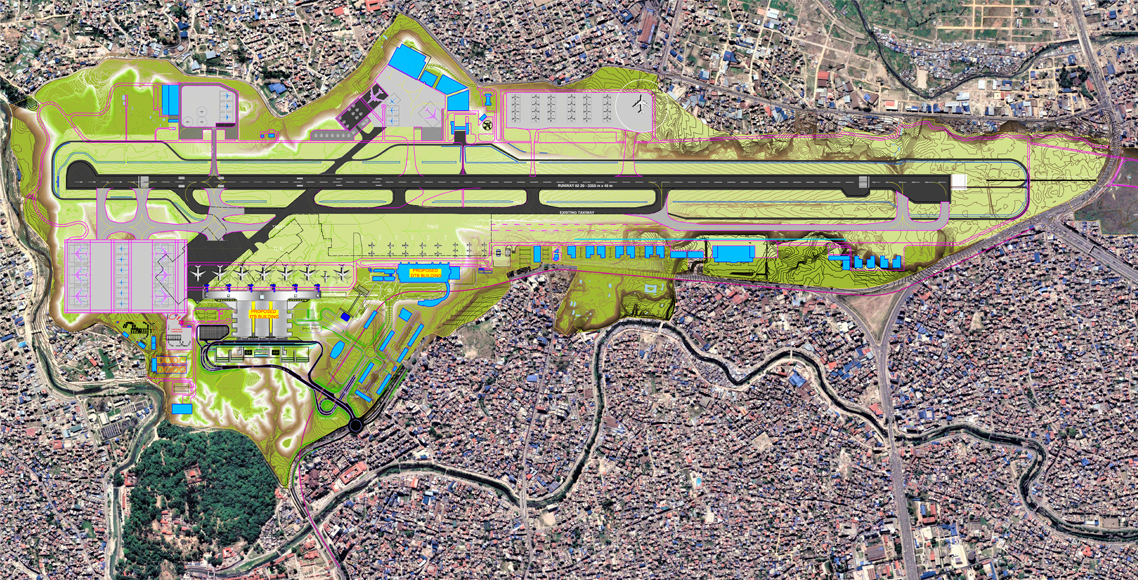Kathmandu : As per the plan of the Civil Aviation Authority of Nepal, Tribhuvan International Airport (TIA) will be expanded to accommodate 10 million passengers annually. The project is estimated to require an investment of NPR 50 billion. Currently, the airport can accommodate 11 international aircraft with wide-body and narrow-body parking facilities.


However, according to the expansion plan, once the apron and terminal buildings are completed, the airport will be able to park up to 22 wide-body and narrow-body aircraft simultaneously.
The expansion of the airport started with the widening and lengthening of the runway three years ago, with an investment of nearly NPR 1 billion. The previous 3,000-meter long runway has now been extended to 3,353 meters. According to the expansion plan, five additional structures can be constructed at the airport, including three for lease. The construction of the terminal building has already received approval from the board.
There is also a plan to build aprons (aircraft parking areas) for 24 internal flights. Although mentioned in the expansion plan, the progress on this project has been slow.

According to the Director of the Airport Capacity Enhancement Program, Dipendra Shrestha, “We cannot add many structures to Tribhuvan International Airport as per the master plan. Once the plan is complete, the airport will be able to handle up to 10 million passengers annually.”
In the last five months alone, Tribhuvan International Airport has handled 1,843,000 international passengers.


Nepal Airlines and the military’s structure are being discussed in relation to the proposed new terminal building. Nepal Airlines’ hangar and the military barracks are also included in the designated location. The authority has provided alternative space for the Civil Aviation Authority and the Nepali Army to construct a new terminal building and apron.
Preparations are underway to accommodate Nepal Airlines and the military’s structure at the current location of the Buddha Air hangar.
“We will construct the desired structure for the airlines. The building will be constructed by ourselves,” said the representative. “We have already designed Nepal Airlines’ building. Now, they are only responsible for the construction of the structure.”
According to the old master plan from 1990, there was a plan to build an international terminal building at the proposed location. CDE/CECCCL obtained a contract worth 4 billion rupees for the construction of the apron and the hangar. The authority has also received financial support from ADB for this project.

A budget of 7 billion rupees has been allocated for the construction of a ‘remote parking’ for 12 ships. The construction of the remote parking and taxiway on the northern side of Dhawalagiri Road is underway, funded by the Nepal government and the authority.
“Now, we can accommodate 11 ships for parking,” said Shrestha. “The capacity has been doubled. We can park up to 15 wide-bodied and 30 narrow-bodied aircraft.”
Approximately 500 meters of taxiway construction has been contracted along with the remote parking. There will be 6 wide-bodied and 6 narrow-bodied parking spaces available. Currently, the aircraft parked at the remote parking will be boarded from the terminal building just like buses.
The contract for the remote parking and the construction of the northern taxiway has been awarded to an external company. Shrestha, the project director, mentioned that the project has a cost of 7 billion rupees, excluding the runway.

Taxiways Need Improvement: Reduced Holding of Aircraft
Even with the expansion of the runway at the airport, there is still only one taxiway (a road used by aircraft to access the runway) in parallel with the runway. The northern taxiway is approximately 500 meters long, but there is no taxiway on the southern side for about 1,200 meters.
The Civil Aviation Authority has awarded a contract for the construction of parallel taxiways from north to south. With parallel taxiways, the number of takeoffs and landings can increase. Currently, when an aircraft arrives at the airport from the northern side, it takes a long time to reach the runway, causing delays in holding patterns. After the construction of parallel taxiways, aircraft will be able to directly enter the runway from the taxiway, without the need for holding patterns.
“After the construction of parallel taxiways, we can accommodate an additional 4-5 flights,” said Director Shrestha. “This will reduce the time spent by aircraft in holding patterns in the air.”
The distance between the runway and the taxiway is currently only 110 meters. According to international standards, there should be a distance of 172.5 meters between the runway and the taxiway.
The construction of the parallel taxiway on the southern side is being carried out with the assistance of the Asian Development Bank, at a cost of approximately NPR 4 billion. The Chinese company, Ganse Mechanization Construction Engineering, has been involved in the construction work.
New Terminal Building Worth 35 Billion, Access Road from Tilganga
The international terminal of Tribhuvan International Airport currently receives more than 3.5 million passengers annually. The Civil Aviation Authority plans to construct a new terminal building that can accommodate up to 10 million passengers annually, which is three times more than the current capacity.
The new terminal building will have an access road from Tilganga. The majority of Tribhuvan Army Officers Golf Course will be used for the construction of the new terminal building.




COMMENTS